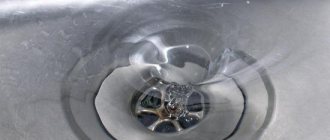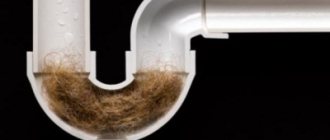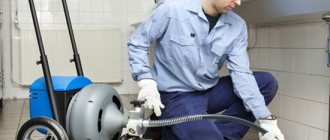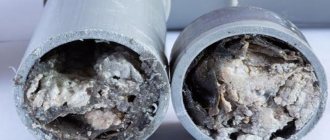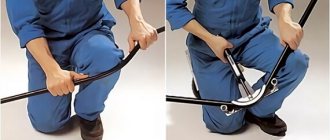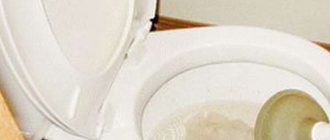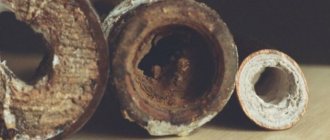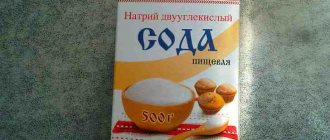A clogged toilet is a common and annoying problem that requires quick fix.
You can unclog a toilet using mechanical and chemical methods. In complex cases that cannot be corrected on your own, you will need the help of a plumber.
In this article we will tell you how to quickly clear a clogged toilet at home.
Reasons for the problem
A clogged toilet needs to be cleaned immediately. The problem is often caused by the following circumstances:
- entry into the drain of foreign objects that interfere with the passage (rags, personal hygiene items, etc.);
- defects in the toilet itself;
- violations in the sewer system;
- improper installation of the structure;
- deposits on the inside of pipes.
Before you start cleaning, you need to determine whether the problem is local, affecting only the toilet, or whether the entire drain system is clogged. To do this, open the taps in the bathroom and sinks and watch how quickly the water drains.
If the water drains quickly, then the problem is only related to the toilet, and you can solve it yourself. Otherwise, professional help will be needed. Violation of the rules for using plumbing is the main cause of blockages.
The second option is to use soda
The second cleaning option is to use baking soda. Washing soda ash is better suited for punching the gap, but baking soda is also possible. Some experienced housewives recommend adding regular salt - about half the amount of soda.
Washing soda ash is suitable for cleaning toilets and sewer pipes.
- Take a pack of soda (500 grams) and pour it into the toilet.
- Then the toilet is filled with a liter of boiling water. After this, a reaction will begin inside the knee, which can also clear it of the blockage. Soda is an active alkali that can dissolve many substances, so it is often used not only for cleaning plumbing fixtures, but also kitchen accessories.
How to eliminate mechanically?
When choosing a cleaning method, you must take into account that the effectiveness of removing blockages from the drain depends on the following factors:
- Why is the toilet clogged?
- Old age of the problem.
If the plug is the result of a foreign object, then you must first remove the water from the bottom of the toilet. For this purpose, you can use rags and sponges.
If the blockage happened recently, you can try to remove the stuck object with a gloved hand. In cases where this fails, they proceed to mechanical cleaning or use a chemical method.
plunger
A plunger is one of the simplest and therefore popular means of removing blockages in pipes. There are a lot of varieties and modifications of this instrument .
Ordinary
If the blockage is not complete and the water gradually drains away, it just happens slowly, even the most ordinary plunger of a familiar shape will help solve the problem.
When purchasing, you must take into account the toilet model, as not all types of plungers may be suitable. The technology of work is to make forward movements, pressing on the handle and sharply lifting it up.
The simplest plunger is recommended to be used only in untreated cases , since in case of severe blockage it will not be effective.
Pneumatic
It is much more convenient and effective to use a pneumatic plunger for problems with the toilet. Outwardly, it looks like a hand pump. This device is not only very effective, but also universal - it is suitable for almost any toilet model.
Advantages of pneumatic valves:
- compactness;
- ergonomic shape;
- set of nozzles included;
- ease of use;
- versatility.
Aeration
Aeration models are designed to regulate air in the system. This helps prevent debris from getting stuck in the toilet and drain pipes.
Cables
For complex blockages, it is more effective than a plunger to use a special metal (less often plastic) cable designed for cleaning. It has a fairly simple device and does not require special skills to use. There is a special tip at the end of the device.
Metal cables have proven to be the most reliable. This design will be more efficient and last longer.
Procedure:
Free up space around the toilet.- Wear personal protective equipment.
- Prepare a bag for placing the removed waste in it.
- Insert the cable from the end into the toilet.
- Rotate the cable using the handle so as to break through the blockage.
- Remove the cable. There may be debris at the end that needs to be removed and placed in a bag.
- Wash away any remaining dirt with a stream of water.
After use, the cable should be cleaned and dried. It is better to store it rolled up.
Plastic bottle
In cases where there is neither a cable nor a plunger available, you can use a regular plastic mineral water bottle with a volume of 1.5, 2 or 2.5 liters.
Application procedure:
- The bottom is cut off from an empty bottle with a knife, but the cap is not screwed off;
- lower the bottle with the cut part down;
- turn the bottle without removing it so that a vacuum is formed;
- press the top edge of the bottle with a sharp movement so as to push the blockage further, pushing it into the riser;
- remove the bottle;
- if necessary, repeat the processing.
You can watch the process of clearing a blockage without a plunger in the video:
Who to call if the toilet is clogged?
Of course, it makes no difference to the emergency service - private or public. After all, in this case, speed is important, not departmental affiliation. Therefore, dial any phone number that catches your eye on the Internet or in a directory.
Just don’t forget to check the cost of the emergency crew. The average price per visit is 4000-5000 rubles. At the same time, mechanical cleaning (with a cable) costs from 2000 rubles. And flushing the system using a hydrodynamic nozzle (a jet of water under enormous pressure) costs from 8,000 rubles.
How to remove using folk remedies?
If you don’t have special household chemicals on hand, you can try to clear the clog with home remedies.
The easiest option is to pour in a bucket of hot, but not boiling, water. Let it stand. This option will help if the problem arose due to food debris or when wood cat litter gets into the toilet bowl.
Soda
To remove a blockage caused by pouring fatty foods into the toilet, you can use a soda solution. To do this, dilute ½ pack of soda in 2-3 liters of water and pour it into the toilet .
After 3 hours, the blockage should be cleared, since the soda will interact with fatty deposits. For serious blockages and those whose cause is unknown, this method is not suitable due to its poor effectiveness.
Soda and vinegar
To clean, you must perform the following steps:
- Pour ½ pack of soda into the toilet.
- Pour in a bottle of vinegar.
- Close the drain hole.
- Leave for 2 hours to act.
- Pour in hot water.
- Wait an hour.
The method is quite effective if the cause of the blockage is organic matter or buildup in the pipes.
Soda and salt
Procedure:
- pour 1 cup of soda into a container;
- add 1 cup salt;
- mix;
- fall asleep in the toilet;
- after 5 minutes, pour 1 cup of boiling water in a thin stream;
- leave for several hours to act.
It is recommended to use this method at night.
The first option is to use boiling water
The first way to get rid of a blockage is boiling water. However, this method and all others that use boiling water can be used if the toilet is connected to the riser with a plastic or metal pipe. If a corrugated pipe made of thin plastic is used to connect the toilet, then hot water should be used instead of boiling water.
- To clean, you will need a bucket of boiling water. It must be poured as quickly as possible not onto the walls of the toilet bowl, but into its opening, so that the boiling water immediately enters the knee canal.
- After pouring water, you must wait 30÷35 minutes.
A bucket of boiling water often helps to deal with a recently clogged toilet. But this method is not always acceptable!
- If the boiling water took effect and the water began to go away, then after it leaves, the procedure must be repeated. And so on until the normal function of the toilet is restored.
How to quickly remove with special chemicals?
In stores you can find a large number of pipe cleaning and sewer maintenance products. The drugs are available in various forms, differing in price , exposure time and composition.
Most household chemicals used to remove blockages have an aggressive composition, so they should be used strictly according to the instructions and in compliance with safety precautions.
Sanox gel Pure stock
The drug is intended for pipes - eliminates odors and blockages. The composition contains surfactants. Suitable for use when organizing sewerage with plastic and cast iron pipes.
Advantages of the product:
- low cost;
- ease of use;
- efficiency;
- price;
- suitable as a means of prevention.
Minuses:
- it takes time to achieve results;
- may not help with serious blockages.
The price, depending on the point of sale, can be up to 100 rubles. Read reviews here and here.
Mr.Muscle active gel
The product is available in liquid form, completely ready for use. For mild blockages, the exposure time is literally a few minutes due to the high concentration of active components. If the water stopper is caked and hardened, Mr. Muscle may need several hours to work.
Advantages:
- high efficiency;
- active composition;
- fast action;
- ease of use.
Minuses:
- caustic composition;
- price;
- For severe blockages it will take several hours.
Price – about 300 rubles for a 0.5 liter bottle. In the same series of products, the manufacturer produces not only gel, but also sachets with powder for removing blockages. Read reviews here and here.
Deboucher
The product is designed to clear sewer blockages. It has a thick form, actively interacts with substances that impede the passage of water, and eliminates odors.
Advantages:
- fast action;
- efficiency;
- safety for all types of pipes.
Cons: high consumption. The cost is about 200 rubles on average. Read reviews here.
Let's sum it up
The most effective way to clear a drain from clay, cat litter, fresh fruit or other solid objects is a cable. The hydraulic method is indispensable for fatty blockages. And household chemicals specialize in eliminating food waste. Most often it is sold in portioned bags containing special granules or powder. Preventative chemicals intended for monthly use are sold in the form of gels and thinner substances.
Video on the topic
Knowing how to unclog a toilet yourself if it’s clogged will not prevent it from becoming clogged. But regular and unconditional compliance with preventive measures and operating rules for plumbing will certainly keep this unpleasant problem away from you. It’s not for nothing that they say: “Forewarned is forearmed.”
Preventive measures
Prevention of occurrence is the following list of measures:
- Installation of new equipment must be carried out in accordance with all rules.
- It is unacceptable to throw garbage, cat litter, leftover fatty food, etc. into the toilet.
- Regular care of your plumbing fixtures and periodic cleaning will help reduce the accumulation of various deposits.
- Flushing the tank after using the toilet will allow the pipes to be flushed and will prevent sediment from accumulating.
- If it is necessary to replace pipes, the new ones must be identical in size to the old ones. Plastic is preferable to metal, as it has a smoother surface that is less prone to the formation of deposits and blockages.
- When carrying out repairs in a toilet room, the toilet lid must be lowered. This will prevent construction debris from accidentally getting inside.
- At least once a week, the toilet should be cleaned using household chemicals to prevent the formation of sediment and deposits.
When do you need a plumber
If you cannot break through the toilet using available means, all methods and means of clearing blockages have not brought results, you need to think about calling specialists. They can inspect the plumbing and determine whether it is necessary to try to restore normal functioning or install new equipment.
This is especially true when the plumbing equipment is old, the drain hole in it is overgrown with a layer of urinary stone by about 15 mm. The plumber will quickly remove a massive dirt plug or remove the stuck object.
Recommendations
Recommendations from plumbers will help you cope with the cleaning task efficiently and without unpleasant consequences:
- If you discover that the toilet is clogged, you should not try to immediately drain the water from the tank. It must be taken into account that the volume of water contained in it is several liters. If it drains into the bowl, some of it may even splash out onto the floor.
- If any object accidentally falls into the toilet, for example, a toy, keys, etc., then you should not press the flush, as this may cause a blockage. In this case, you need to put on rubber gloves and take out the item.
- All pipe cleaning work should be done with rubber gloves, even when traditional methods of clearing blockages are used.
- It is more convenient for two people to break through a blockage using a cable, when one person rotates using a handle, and the other directs the cable itself to the place of the blockage.
If you are interested in how to clear a clog in a pipe, sink or toilet, take a look at this section.
Localization of the blockage
It is important to determine the location of the plug. For this purpose, check how the water leaves the washbasin or bathtub. If everything is in order, then the blockage has formed in the toilet siphon, outlet or cuff connecting it to the sewer pipe. If the water from the bathtub also does not flow well, the blockage is localized somewhere in the common pipe.
If the drains flow out of the toilet like a fountain, then the riser is clogged. Residents on the upper floors should be asked not to use the sewer and immediately call plumbers.
What not to do during a traffic jam
We've sorted out what to do if the toilet is clogged. Here are some tips on what exactly you shouldn’t do, so as not to aggravate the situation.
- Pour Coca-Cola down the toilet. On the Internet you can find many life hacks about this, but it is better not to check the magical properties of this drink and buy professional chemistry.
- Use cleaning products. Whitening or dishwashing detergent will not help the situation. They are not able to break down even small debris.
- Try to clear the blockage by draining the tank. If the blockage is serious, water will flow out. Don't experiment.
The third option is a combination of soda and vinegar
The third cleaning method also includes soda ash, but in addition to it, vinegar and boiling water are used in this case.
- One and a half packs of soda (that is, 750 grams) are poured into the drain area.
- A glass or 0.5 liter of 9% vinegar is poured into it. When vinegar is poured in, a reaction should begin, accompanied by hissing and the formation of foam. This mixture must be left for 20÷25 minutes.
- After waiting this time, pour 2–3 liters of boiling water into the toilet and leave again for 15–20 minutes. After this, you can try rinsing with plain water.
Using film
Another way to fix the problem is to use thick cling film or tape. This method creates a vacuum inside the toilet, helping the clog move through the pipe. The effect is similar to using a plunger.
- It is necessary to wipe the toilet dry by lifting the lid. This is necessary so that the tape or cling film fits tightly to the toilet.
- Cover the toilet hole completely with film. Everything should be sealed, without cracks.
- Drain the water from the tank and press firmly on the film plane.
- Repeat this method two to three times until you see the result. Carefully remove any remaining film from the surface of the toilet.
